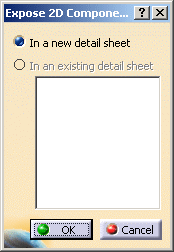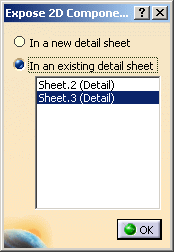When instantiating a 2D component, you can define its type as an exposed one. For this, use the Expose
![]() icon from the Tools Palette
toolbar, as explained in the Instantiating a 2D component from a catalog
user task.
icon from the Tools Palette
toolbar, as explained in the Instantiating a 2D component from a catalog
user task.
In a given document, all 2D component instances that were linked to the former 2D component catalog reference will then link to the exposed 2D component reference. This will also allow you to modify the 2D component reference locally (without modifying the 2D component catalog reference).
-
Right-click the 2D component instance in the layout view, and select Special K10.X object > Expose 2D Component. The Expose 2D Component Instance dialog box is displayed.

As no detail sheet exists in this drawing, a detail sheet will be created for the 2D component. Therefore, the In a new detail sheet option is selected. The other option is unavailable.

In the case of a drawing with an existing detail sheet, you can specify whether you want the 2D component to be created in a new detail sheet or in an existing detail sheet by selecting the appropriate option. In the latter case, you can then select the detail sheet in which you want to create the 2D component from the list underneath. 
-
Click OK. All links are now cut between the 2D component instance and its catalog reference.
-
In the detail sheet, you can now modify the 2D component reference. For example, add a text indicating the component's name.

In this scenario, text is modified as an example of 2D component reference modification. However, the Modifiable in instance contextual command is specifically intended for modifying texts in 2D component instances. See Re-Using a 2D Component for more information on modifying text in 2D component instances. The 2D component instance has been modified in the sheet. On the other hand, the 2D component reference in the catalog is left unchanged.
![]()